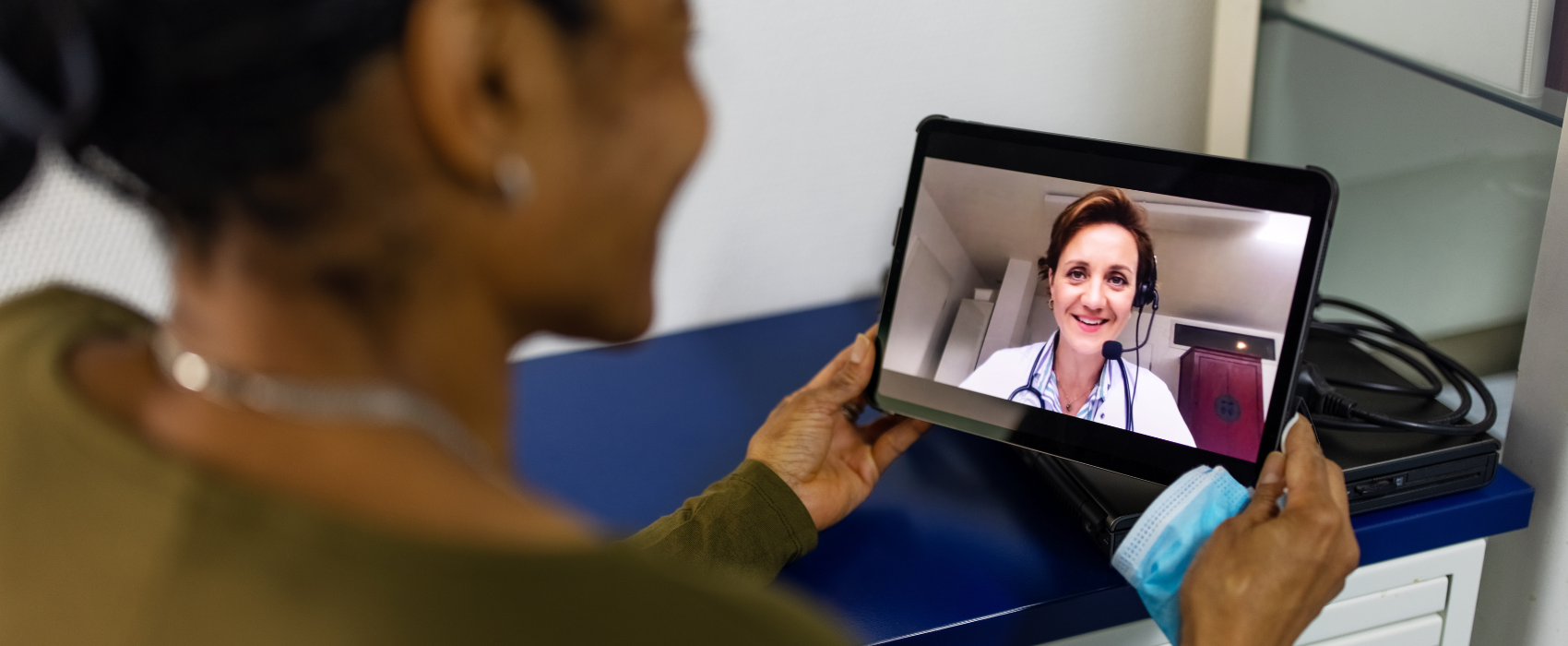
The adoption of telemedicine became increasingly important during the COVID-19 pandemic. It was implemented to help alleviate burdens in many overworked and understaffed hospitals, clinics, and doctor's offices nationwide. However, as the viral spread became more manageable and access to care became easier for non-COVID-related conditions, telemedicine consultations continued to be embraced and, in some situations, preferred. But can they really provide optimal care for patients who need urological care? Here, we'll go over all of the advantages and limitations of urological telemedicine.
What is Telemedicine and Telehealth?
Telemedicine and telehealth are terms often used interchangeably but encompass slightly different aspects of remote healthcare delivery. Both refer to the utilization of digital communication technologies to provide healthcare services remotely.
What is Telemedicine?
Telemedicine specifically refers to the remote diagnosis and treatment of patients using telecommunications technology. It involves exchanging medical information between a patient and a healthcare provider who may be located at different geographical locations. Telemedicine encompasses various forms of communication technology, including video conferencing, phone calls, text messages, and secure messaging platforms.
Two primary components of telemedicine can be used: synchronous telemedicine and asynchronous telemedicine.
Synchronous telemedicine involves real-time communication between a patient and a urologist. Video conferencing is the most common method, as it allows for virtual face-to-face interactions.
Asynchronous telemedicine, also known as "store-and-forward" telemedicine, involves the transmission of medical data (such as images, videos, or test results) to a urologist who reviews it at a later time. It doesn't require simultaneous interaction between the patient and provider.
What is Telehealth?
Telehealth is a broader term encompassing clinical and non-clinical services, such as health education, administrative meetings, and provider training conducted remotely. Therefore, it is used more between urology departments than with patients. Telehealth includes a wider range of healthcare services beyond diagnosis and treatment. It focuses on improving accessibility, efficiency, and healthcare quality through technology.
Both telemedicine and telehealth play crucial roles in enhancing access to healthcare, improving patient outcomes, strengthening patient satisfaction, and optimizing healthcare delivery systems.
Advantages of Implementing Telemedicine Services
The practice of telemedicine in urology allows doctors to assess and treat a variety of different urologic conditions remotely. This may involve things as simple as infection but can even be used to help address certain types of cancers. This is particularly advantageous in rural communities with less access to urology clinics or specialists. Rather than succumbing to excessive travel times, patients and urologists can schedule telemedicine visits for initial consultations to determine the next steps.
Telemedicine and telehealth also increase patients' access to information based on lab or imaging tests. When paired with improved access, telemedicine can drastically improve the overall convenience of routine communication between a patient and physician. Other benefits include:
- Cost-Effective: Telemedicine can be more affordable for both patients and healthcare providers, as it reduces overhead costs associated with traditional in-person visits.
- Time Efficiency: Patients can often schedule appointments more quickly, leading to faster diagnoses and treatment.
- Continuity of Care: Telemedicine facilitates easier follow-up consultations and ongoing monitoring, improving continuity of care for chronic conditions.
- Reduced Exposure to Illnesses: Patients can reduce their risk of exposure to contagious illnesses by avoiding crowded waiting rooms.
- Remote Monitoring: Telemedicine enables healthcare providers to monitor patients' vital signs, symptoms, and progress remotely, which is particularly valuable for managing chronic diseases.
- Improved Patient Engagement: Some patients may feel more comfortable discussing sensitive issues or asking questions in a virtual setting, leading to better engagement and communication.
- Healthcare Professional Collaboration: Telemedicine facilitates easier collaboration between healthcare professionals, enabling specialists to consult with primary care providers more efficiently.
- Healthcare Equity: Telemedicine can help bridge gaps in healthcare access, making services more equitable for underserved populations, including those with disabilities or mobility issues.
Acceptable Uses of Telemedicine in Urology
Utilizing telemedicine in urology can be tricky in some situations, but it's a great alternative to in-person patient care for others. In fact, some urologic conditions can be completely diagnosed and treated through telehealth services. The following instances may allow for a telemedicine encounter with your urologist:
- Consultations: Patients can consult healthcare providers remotely for non-emergency medical issues, follow-ups, or second opinions. This can include consultations for hematuria, prostatitis, male sexual dysfunction, low testosterone, male infertility, urinary incontinence, interstitial cystitis (painful bladder syndrome), overactive bladder (OAB), kidney stones and bladder stones, varicoceles, and more.
- Diagnosis and Monitoring: Telemedicine enables healthcare professionals to remotely diagnose and monitor certain conditions, such as chronic diseases, through virtual consultations and remote monitoring devices.
- Preoperative and Postoperative Care: Patients can speak with their doctor before and after undergoing operations or treatments.
- Remote Care Management: Patients can receive ongoing care and management of chronic conditions without the need for frequent in-person visits.
- Emergency Care: In emergencies, telemedicine can facilitate timely consultations between healthcare providers to assess and provide guidance for immediate care
Limitations of Telemedicine and Telehealth in Urology
That said, there are also some limitations when applying telemedicine in urology. Some of the most notable include:
- Technological Barriers: Not all patients have access to the necessary technology or reliable internet connection for telemedicine appointments.
- Limited Physical Examination: Some medical conditions may require hands-on examinations or diagnostic tests that cannot be performed remotely, limiting the scope of telemedicine.
- Privacy Concerns: Transmitting sensitive medical information over digital platforms raises privacy and security concerns, particularly regarding data breaches or unauthorized access.
- Digital Divide: Socioeconomic disparities may exacerbate unequal access to telemedicine services, as those with lower incomes or in rural areas may lack the necessary technology or digital literacy.
- Licensing and Regulation: Telemedicine services may be subject to complex regulations and licensing requirements, limiting healthcare providers' ability to offer services across state or international borders.
- Diagnostic Limitations: Remote consultations may lack access to certain diagnostic tools or imaging equipment, potentially leading to incomplete assessments or misdiagnoses.
- Patient-Provider Relationship: Some patients may prefer in-person interactions for establishing trust and rapport with their healthcare providers, which can be challenging to replicate in a virtual setting.
- Inadequate Reimbursement: In some healthcare systems, telemedicine services may be inadequately reimbursed compared to in-person visits, discouraging healthcare providers from offering them.
- Medico-Legal Issues: Legal frameworks and malpractice laws may not be fully adapted to accommodate telemedicine practice's nuances and potential risks, leading to uncertainties and liabilities.
- Complex Cases: Some medical cases may be too complex or require immediate physical intervention, making telemedicine unsuitable for certain scenarios.
- Insurance Coverage: Insurance coverage for telemedicine services may vary, with some plans offering limited or no coverage, potentially limiting access for certain patients.
- Technology Reliability: Technical glitches, such as connectivity issues or software malfunctions, can disrupt telemedicine appointments and compromise the quality of care provided.
When to Schedule a Visit with Your Urologist
Regardless of a urologist's experience with telemedicine, some situations are not fit for tele-urology. Some types of traditional urology care must be done based on an initial physical examination and in-office diagnostic testing. During your initial consultation, your urologist will let you know whether you need to visit their office.
Urologic emergencies, on the other hand, require immediate medical attention. If you experience any of the following signs or symptoms, it's important that you go to an emergency room or 24-hour clinic to be seen and treated:
- Severe flank pain
- Fever over 100.4 degrees Fahrenheit
- Any severe pain or swelling of the penis paired with chills, fever, and/or bad odors
- Acute urinary retention symptoms — the inability to urinate paired with lower abdomen pain and swelling
- Testicular torsion symptoms — a sudden, severe pain in the scrotum with swelling in a testicle and blood in semen
- Priapism symptoms — a painful erection lasting more than four hours
- Paraphimosis symptoms (in uncircumcised males) — an inability to retract your foreskin to a normal position, resulting in the head of the penis swelling and becoming painful
Urologic conditions are common and can affect individuals of all ages. If you cannot schedule an in-person visit with your urologist, ask them about access to telemedicine or video visits. Follow-up care or care for pre-existing urology patients with diagnoses can often be taken care of online. In cases with new or increasingly severe symptoms, it's best to see your doctor in person, as diagnostic tests will need to be performed.
As you age, taking the time for yearly in-person visits with your urologist is important, especially for proactive prostate care. To help you support your urologic health, Byram Healthcare proudly offers full-service urologic care with high-quality urologic supplies to help you address any issues. Plus, when you order urologic supplies, your packages can be discreetly delivered to your home anytime.




